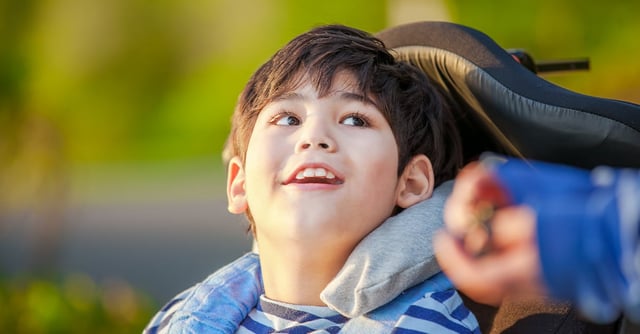
18-Aug-2023Comfort and development – Striking a balance with assistive technology

Back to Blog Overview
When your child has a disability, it is natural to be concerned about comfort. You want to protect your child from discomfort while giving them every opportunity for development.
In this article, we will touch upon:
- The concept of comfort
- Is the concept of comfort the same for children with disabilities?
- Posture and activity for development
- Posture
- Activity
- Combining posture and activity
- Striking the balance using assistive technology
- Parents, you are the experts
The concept of comfort
Comfort as a concept is complex because it is both subjective and nuanced. Your perception of comfort is likely to be slightly different to mine, and each may also change depending on how well we are feeling, how tired, warm or hungry we are, or if we need a bathroom break. There is no single definition of «perfect comfort». But there are some common themes.
From a purely physiological perspective, comfort tends to be measured in terms of lack of pain, feeling secure, or having the just right balance of being full, warm and not needing the bathroom. From a sensory perspective, comfort relates to background noise and lighting levels being tolerable, no overpowering smells, and when we are unaware of our clothing, footwear and the surface we are on. Then, there is emotional comfort – being out of our «comfort zone» is considered beneficial for our personal growth and learning, while bringing comfort implies reducing negative emotions and soothing distress.
Even if initially comfortable, the time we spend in one position or engaged in any activity will eventually reduce our comfort, as our brains register the need to vary position, eat, drink, use the bathroom, turn the volume up/down, or change out of tight pants.
Comfort isn’t necessary 100% of the time. We may be prepared to tolerate a little discomfort for a short time if the purpose is considered important – such as a visit to the dentist, or the outcome is perceived as worth it – perhaps a difficult workout. Overall, however, maintaining comfort – whichever way we uniquely experience it – is a basic human need. It drives our frequent adjustments (of which we are largely unaware until we become uncomfortable) so we can continue as effectively as possible with our daily lives.
Is the concept of comfort the same for children with disabilities?
Yes, broadly. However, a child with a disability may find it difficult to hold their body in a stable position against gravity, move freely, recognise and communicate their needs, or respond in a regulated way to overwhelming sensory stimuli. For them, frequent adjustments are likely to be more difficult, so comfort is less able to take care of itself in the background. Maintaining comfort relies on your watchful eyes, while providing the «just right» level of postural support for the chosen activity for the required length of time. The complexity of comfort means there is no «one size fits all» solution. It very much depends on:
- The level of postural development your child has attained.
- How much your child’s postural stability is interrupted by tone, reflexes, or seizures.
- The match between your child’s postural needs and appropriate assistive technology solutions.
- The intended purpose of the assistive technology they are using.
Posture and activity for development
Posture can be defined as «the position in which someone holds their body». Activity can be defined as «action, movement, motion, interest, hobby or occupation» (Oxford Languages).
Although posture and activity are so tightly interwoven that your child’s posture is determined by the activities they want to do, and the quality of activities they carry out is determined by their posture, we will attempt to separate them a little here.
Posture
Posture (the way your child holds their body) depends on their level of postural maturity. For your child, achieving a range of postures independently may take longer, or may not be possible without additional support. Variations in muscle tone or strong reflexes can lead to changes in body shape, loss of movement, fixed deformities and asymmetry – all of which need to be clearly understood in order to provide comfortable assistive technology solutions - the range of lying, sitting, standing and moving equipment which gives external support where it is needed.
Your occupational therapist or physical therapist can determine your child’s postural needs by carrying out a detailed postural assessment. This involves taking various measurements of length and range of movement in different positions and matching your child’s individual body shape to a suitable piece of assistive technology for the intended purpose or activity. This should be repeated ideally every six months, but at least annually to capture any changes.
If your child has cerebral palsy, therapists may also use a measure called the Gross Motor Function Classification System (GMFCS) (Palisano et al, 2007) to identify the level of their physical abilities. In turn, this guides us towards the most appropriate assistive technology solutions. Generally, children at GMFCS levels IV and V are those who need the most complex types of equipment.
Best practice in postural management suggests that children should have access to assistive technology from the developmentally appropriate age. So, even if they need support, they should be sitting from around six months old, and standing from around 12 months. Research has also shown that early powered mobility (under the age of five years) is likely to have a positive effect on development (Bray et al, 2020).
Activity
Therapists (including me) tend to talk about activities in terms of function, focusing on movement and self-care (hand function, dressing, feeding), but this is only part of a child’s development.
Canchild’s «F-words for Child Development» (https://www.canchild.ca/en/research-in-practice/f-words-in-childhood-disability) remind us there six key areas of child development:
- Functioning – what your child does
- Family – the essential environment for your child
- Fitness – the physical and mental well-being of your child
- Fun – activities your child enjoys
- Friends – friendships your child establishes with others
- Future – what life is all about for your child
Although more attention is often paid to function, all six areas are of equal importance and should be taken into account when trying to balance comfort, posture and activity through the provision of assistive technology.
Combining posture and activity
Humans are not designed to sleep standing up. While we may be able to doze in a chair, we are unlikely to experience quality sleep. Our body is unstable because we do not have the right support in the right places. Over time our head droops and jolts us awake. Therefore, the most comfortable posture for the activity of sleep is reclined or lying down. Conversely, it is very difficult to eat when lying down – it is challenging to swallow, and we risk choking and spillage. We can eat standing up if we don’t need to use a knife and fork, but it takes more time and effort as we are not very stable. Therefore, the most efficient and comfortable posture for eating is sitting upright on a chair with back support and our feet on the floor. This allows us to use our hands to manipulate cutlery, keeps our head and neck in alignment for a safe swallow, and ensures our body is sufficiently supported for the duration of the activity.
It’s always a trade-off between stability and support depending on the activity we are doing.
In general, the more difficult we find an activity, the more stable our posture needs to be.
Striking the balance using assistive technology
Assistive technology – the equipment your child uses to help them daily – is the means by which external support is provided to allow your child to achieve or maintain postures they would otherwise find too difficult.
For children with a disability, the inability to make postural adjustments means that more attention must be given to stability. This is where it is useful to be clear about your child’s postural needs in the context of the activity they are doing, and for what duration (remember, the postural assessment). If your child needs assistive technology to sit up, their wheelchair or seating system must provide enough stability and support for longer periods of time. Posture can still be altered. For example, tilting backwards will provide a more restful posture, or removing the chest harness when sitting upright with a tray fitted may encourage further arm and hand reach. A height adjustment is helpful for family, fun and friends' interaction.
However, if you are an outdoors family who enjoys hiking or cycling off-road, a conventional wheelchair or special seat is unlikely to meet that need. Off-road pushchairs or bike trailers are a great assistive technology solution – but tend to have less postural support. And, within reason, that’s completely fine for the duration of your family activity.
The physical, sensory and emotional benefits of fresh air, nature, enjoyment and family time, far outweighs the lack of «correct» postural support.
Stability (and therefore, comfort) in assistive technology is achieved using the combination of support surfaces along with straps and additional pads, matched to your child’s body shape. If you find that your child finds it very difficult to maintain a posture for a reasonable length of time – and they are in familiar equipment and not doing an activity they find difficult; OR additional support or straps have been added which make no difference, it is a clear indication that the assistive technology solution either no longer suits or needs adjusted.
Remember too, that assistive technology may offer an opportunity for therapeutic or developmental opportunities, but these should not be used for prolonged periods at the expense of comfort. I mentioned earlier about removing the chest harness on a seat or wheelchair to allow greater arm and hand movement – this is completely fine for a short activity, such as turning the pages of a book, eating or doing a jigsaw. However, your child’s trunk stability will be reduced, and your child will be working harder overall, so it’s a good idea to replace the harness when the activity is complete. Going for a walk with the harness off «to work on trunk stability» is not using the equipment in the intended way (floor based or standing activities are more appropriate to work on trunk stability) and will result in discomfort for your child.
Parents, you are the experts
It is my overwhelming experience that parents of children with disabilities are experts about their child. You may not know all the therapy terms (although most of you do), but if not, you instinctively know what is best for your child. You understand their likes and dislikes and can read the signs of discomfort much earlier than most others involved in your child’s care. I have found that it is often assistive technology recommended or set up by therapists which causes the most concern about your child’s comfort. Do not be afraid to seek reviews, and if need be, another opinion. Assistive technology can absolutely help you strike the balance between your child’s comfort and development, and it is very much a team effort.

Clare has 27 years' experience as a paediatric occupational therapist. After graduating in 1994 with honours in OT from Ulster University, Clare worked with children and young people in special schools and their homes, in private and charity sectors, and achieved a Master's degree in Clinical Research.

